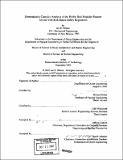Deterministic casualty analysis of the Pebble Bed Modular Reactor for use with risk-based safety regulation
Author(s)
Withee, Jon E. (Jon Erek), 1970-
DownloadFull printable version (11.77Mb)
Alternative title
Deterministic casualty analysis of the PBMR for use with risk-based safety regulation
Other Contributors
Massachusetts Institute of Technology. Dept. of Nuclear Engineering.
Advisor
Michael Golay.
Terms of use
Metadata
Show full item recordAbstract
The resurgence of interest in the use of nuclear technology for electrical power production has resulted in a desire to improve the existing licensing structure. Improving the licensing structure will result in reduced design time and cost for new reactor plants. An improved regulatory process is also necessary in order to license advanced reactors that are not light water technology. Risk based reactor licensing, which uses the Probabilistic Risk Assessment (PRA) to justify most licensing questions, is a proposed replacement for the current methods. This work further develops the risk-based regulatory process by analyzing a portion of a new reactor concept. A reactor similar to the Pebble Bed Modular Reactor (PBMR) is the design chosen for the analyses. The designers of the PBMR assert that the reactor's inherently safe design justifies the use of a non-standard containment system. This assertion can be treated as a design question to be justified using the risk-based approach. The effect of the changing the containment system is incorporated into the PRA for the PBMR. The contributions to the event and fault trees of the PBMR are determined for two casualties that affect the plants decay heat removal system. The initiating event for both of these casualties is assumed to be a beyond design basis earthquake. The first casualty is steam blanketing of the reactor vessel due to a rupture in the Reactor Cavity Cooling System (RCCS). This casualty is shown to have little effect on the safety of the plant. The second casualty was failure of the RCCS due to operator inaction. If this casualty were to occur the reactor vessel has the possibility of failing catastrophically. The failure of the reactor vessel could result in damage to the fuel and release of radionuclides. The probability of this casualty resulting in a significant release of radionuclides is 7.5-10-11 / year. For the two casualties evaluated in this work, the use of a non-standard containment is justified.
Description
Thesis (S.M. in Naval Architecture and Marine Engineering)--Massachusetts Institute of Technology, Dept. of Ocean Engineering; and, (S.M.)--Massachusetts Institute of Technology, Dept. of Nuclear Engineering, 2002. Includes bibliographical references (leaves 77-78).
Date issued
2002Department
Massachusetts Institute of Technology. Department of Nuclear Engineering; Massachusetts Institute of Technology. Department of Nuclear Science and Engineering; Massachusetts Institute of Technology. Department of Ocean EngineeringPublisher
Massachusetts Institute of Technology
Keywords
Ocean Engineering., Nuclear Engineering.